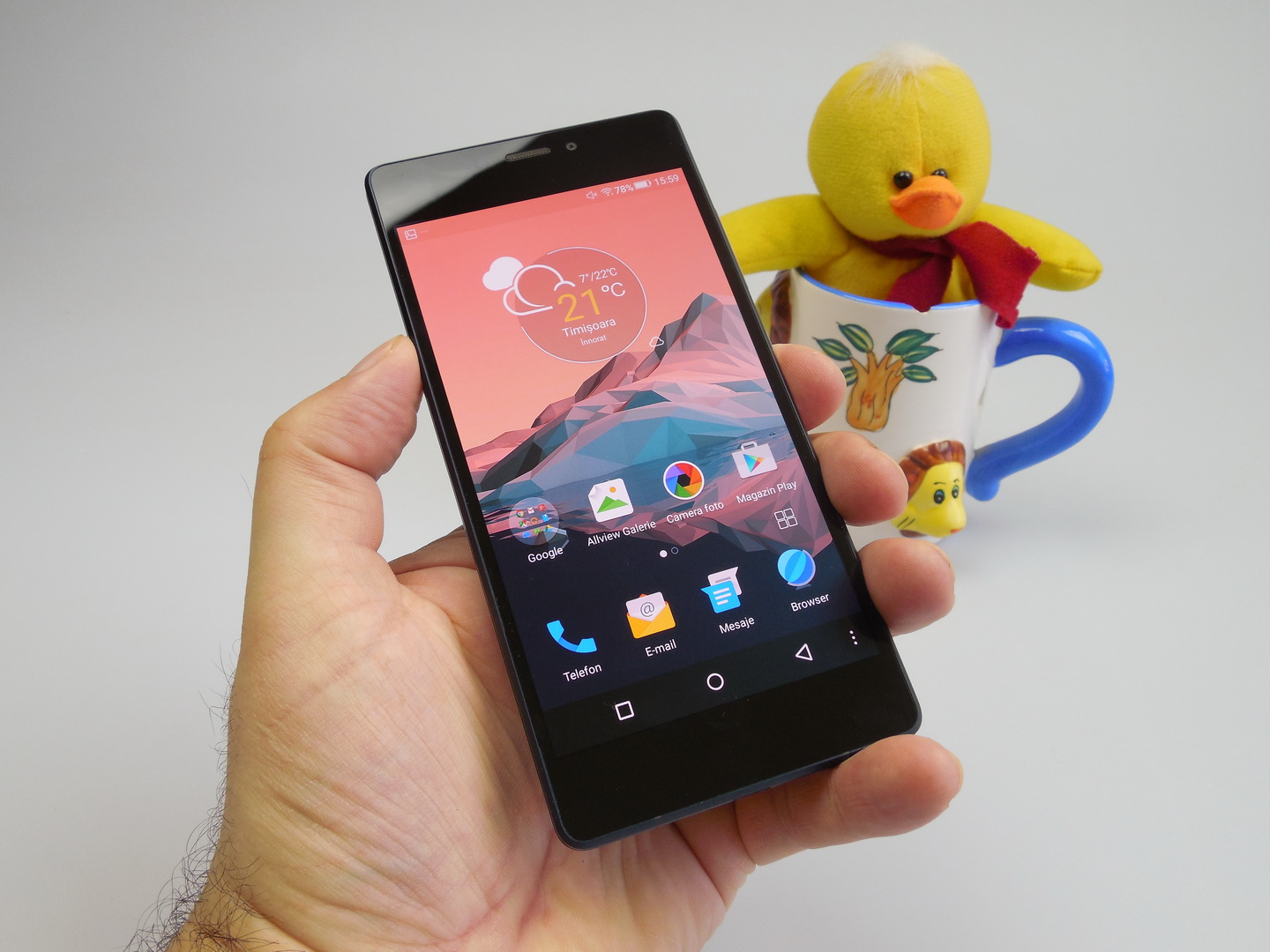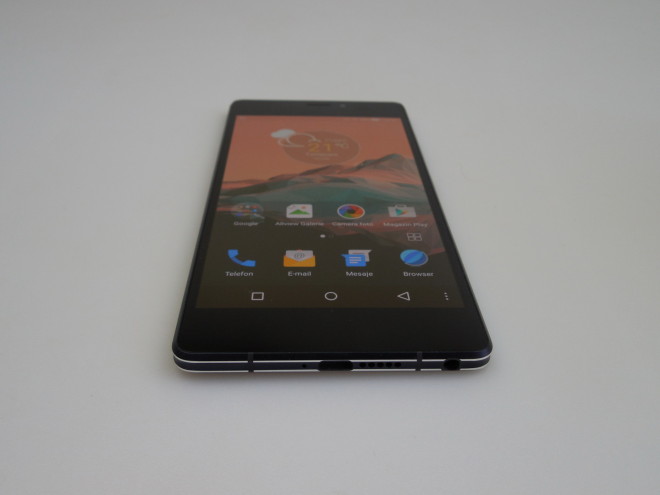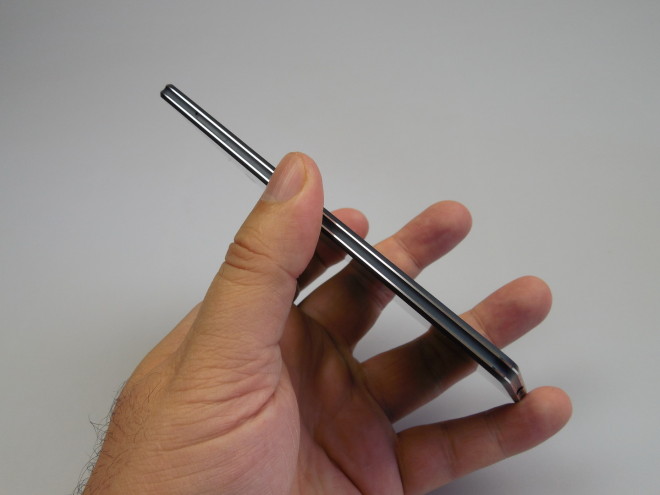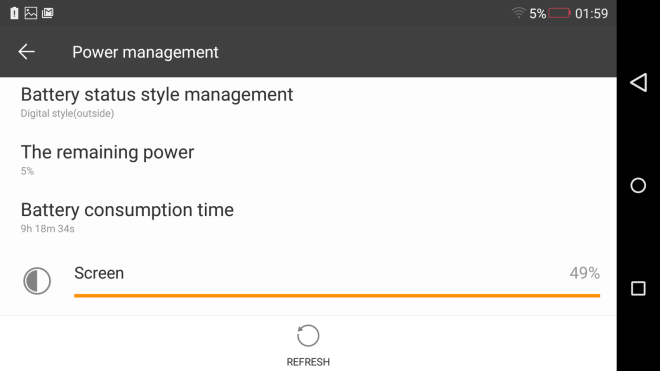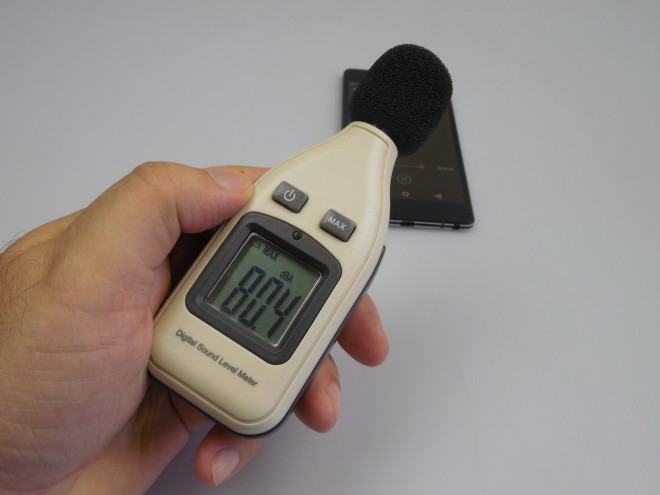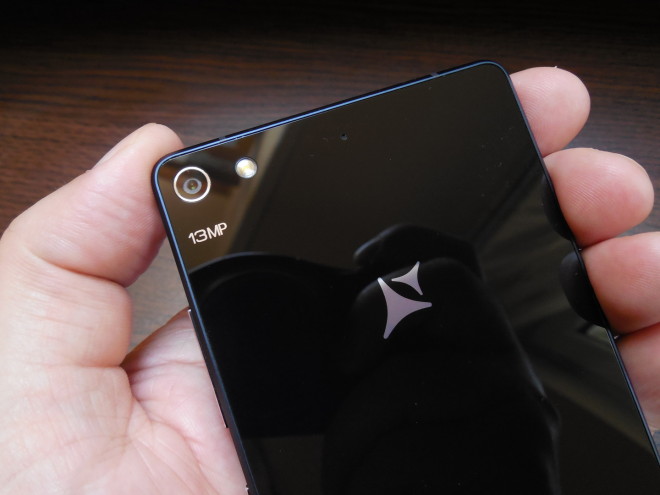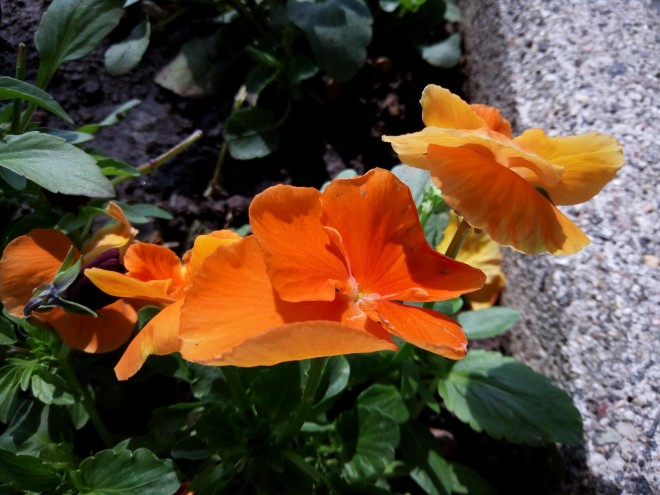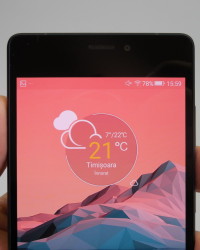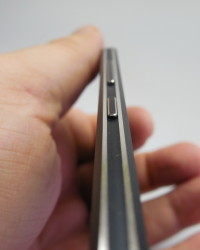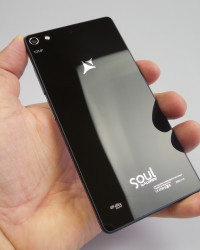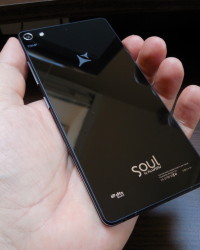Allview is a company from Romania, Eastern Europe, who has been working with brands like Gionee to come up with localized versions of their handsets. By localized I mean customized for the European market. That’s how the Gionee Elife S7 unveiled at MWC 2015 was turned into the Allview X2 Soul Pro. The device is priced at 400 euros and below you can read its review.
By the way, this is the first Allview/Gionee phone that comes with Android 5.0 Lollipop on board. Its design is very slim and involves a 5.5 mm thick chassis and a weight of 126.5 grams. The handset is made of glass and metal, with a glass back and glass front. The frame has chromed lines and the smartphone comes in black or white and gold.
Its internal chassis is made of an alloy of aluminum and magnesium. CNC machining is used here, a 100% automatized process and all the parts are kept as slim as possible. The display is 1.4 mm thick, the back and front glass are each 0.4 mm in waistline, the camera measures 4.37 mm and the battery 3.2 mm. The sides are a bit concave, with a small cut between the two metal edges, increasing the grip.
The handset is not slippery, in spite of using glass and it offers a pretty OK one hand usage. It also feels pretty solid. The facade brings an earpiece, front camera and notification LED, as well as sensors, while the screen is a 5.2 incher with not very narrow bezels. At the back there’s the main camera and LED flash, plus a mic, while at the top nothing.
The bottom hosts the audio jack, microUSB, microphone and speaker, while the left side brings a tray with the two microSIM slots on it. The right side finally offers access to the volume buttons and On/Off button, that are very comfy to press. The Allview X2 Soul Pro/Gionee Elife S7 manages to be a masculine and good looking phone, in spite of being so thin.
The idea of the concave edges makes it stand out of the crowd. As far as the hardware goes, we’ve got here a 5.2 inch Full HD Super AMOLED screen, as well as an octa core Cortex A53 1.7 GHz processor, a MediaTek MT6752 chipset, with a Mali T760 GPU. There’s 2 GB of RAM inside and only 16 GB of storage, without a microSD card slot. The back camera is a 13 MP unit and the front one an 8 MP unit.
On the connectivity front, we get 4G LTE, with a top download speed of 150 Mbps, HSDPA, with the max download speed of 21 Mbps, Bluetooth 4.0, WiFi 802.11 b/g/n, WiFi Direct and WiFi Display. There’s OTG and microUSB connectivity here. The sensors on the handset are the accelerometer, proximity sensor, light sensor and magnetic one. The battery is a Li-Po unit, with a 2700 mAh capacity and the device comes with a 5V/2000 mA charger. On paper, the battery offers 270 hours of standby or 770 minutes of talk time.
In our test, that involves HD video playback in a loop, with WiFi on, brightness at 50% we had a bit of a surprise. You’d expect a 5.5 mm thick phone to not deliver, but this one did and in style. It reached hours and 54 minutes of playback time, which is just WOW. It beat the Galaxy S6, that scores 9 hours and 49 minutes and it went a bit below the HTC One M8, with its 10 hours and 15 minutes. It’s still far from the iPhone 6 Plus’ 12 hours, but the performance remains great.
The PCMark test we also did involves continuous use with brightness at 200 LUX and in this one we reached 7 hours and 23 minutes, which beats every rival, except for another Allview phone, the Allview P6 Energy, that goes as high as 11 hours and 24 minutes. The Galaxy S6 is also pretty close, at 7 hours and 6 minutes. Charging takes 3 hours and 14 minutes and this is not very fast, but it’s worth it. For example, the OnePlus One charges in 1 hour and 15 minutes, so that’s a big difference.
The Allview X2 Soul Pro has a special cooling system, that uniformly propagates heat, using 8 cooling abereas, in order to reduce power consumption. Its screen also comes with a technology called ACL, that reduces consumption by about 25% when using the display, while the CPU has HPM tech, reducing power use by as much as 40%. Finally, in the Settings area you’ll encounter Power Management, with options like Intelligent Power Save at Night, Intelligent Memory Cleanup and Modes. Those are Normal, with features like connectivity, GPS or sync off and CPU Power Save, plus the Extreme Mode. This one offers only the basic features, like phone calling, SMS, contacts and clock, with a minimal black/white UI and at about 90% battery you’ll get 200 hours of usage out of this mode.
Then there’s the Standby Intelligent Power Save, so overall this battery is great. The acoustics bring us DTS sound, 2 players, the Music one and Google Play one. The Music app has a fresh UI compared to the previous Allview UIs. It’s all black and white, minimal and simple. The actual use experience is loud and clear, the sound is crisp and bass is OK. The options include Sleep Timer, Sound Effects (DTS, that makes the sound louder and more ample, plus special earphone settings). We’ve got Standard, Ears, Earphone, Headset and Speaker, depending on your output accessory.
Effects include Classic, Dance, Jazz, Metal or Rock and the EQ has 5 channels. The headphones bundled here are nice looking, they’re light, feel like metal and they have a wire that kind of tangles. The remote is big and its buttons are noisy. This accessory delivers a comfy experience, good isolation and high volume. Then we get to the Audio Enhance special option for headphones, with the following sub options: DTS Focus, DTS Trubass, DTS Space, DTS Definition, DTS Center.
We’ve got FM Radio with features like Search, Speaker and Record FM and then we go to the decibelmeter test. This is where we got 80.4 dBA, which is a good level to hit, especially since the Huawei Honor 6 gets to 81 dBA, Galaxy A5 to only 77.6 dBA and the Huawei P8 to 81.2 dBA. Now, since the audio has been checked as good, we move on to the display. We’re dealing here with a 5.2 inch unit, a Super AMOLED panel with Full HD resolution and OGS technology, as well as full lamination.
The video app has a pop up play style features and the viewing experience is crisp, clear and offers good contrast. Blacks are deep and the screen is bright. Pixels are of the Pentile Matrix kind and this device’s panel is similar to the one of the Galaxy S5, only 0.1 inch bigger. Brightness here is 471 LUX units, close to the Galaxy S5’s 480 LUX and beating the HTC One M8 and its 463 LUX, while also being close to the Galaxy S6’s 475 LUX.
The screen is bright and offers realistic colors, good contrast and wide viewing angles. Settings include Adaptive Brightness, Economical Backlight, Font Size and LCD Effect, that lets you make the image cool, neutral or warm. We leave behind the good screen and analyze the camera, 13 megapixel Sony IMX214 unit, that was also present on the Oppo Find 7 and Xiaomi Mi4, as well as the OnePlus One.
The front camera is a 8 MP shooter with an Omnivision OV8858 sensor, that measures 1/4 of an inch and uses 1.12 micron pixels. Back to the back camera, it also has the same pixel size and the sensor measures 1/3.06 inch. 6 lenses are also included in the setup. On paper Allview claims the camera starts in 0.5 seconds, focuses in 0.5 seconds and takes a picture in 0.1 seconds.
There’s also a single LED flash in the mix and F/2.0 aperture. The camera doest have a fast startup and on the left side of the UI you can find Settings like Anti Banding, Guidelines, Geotagging, Timer, picture size (13 MP in 4:3, or 10 MP in 16:9), as well as Capture Mode (Touch Shot, Gesture Shot and Normal), Sound and then there’s the front camera shortcut.
The front camera brings 720p video capture, pretty much the same options as the back camera and then we proceed to the flash options, also on the same side of the screen, to the left. And then we reach the capture Modes, that offer a rich list: Face Beauty (contrast, slim face, smooth skin, eye enhance), Filter, Night, Pro, Magic Focus, Panorama, Normal, Take Anytime and HDR.
The Pro mode offers the ability to tweak a few sliders associated to clarity, focus mode, shutter speed, white balance, ISO. Magic Focus will focus on a certain part of the shot, while Take Anytime is basically a Best Shot feature. The right side of the UI brings the video settings, stuff like Scene, Anti Banding, microphone, exposure, white balance, anti shake, 1080p/720p res.
Allview X2 Soul Pro has a fluid zoom, fast focus and reasonably fast pic taking. If you keep the screen pressed you can separate the two virtual crosshairs associated to focus and exposure. And now off to the Gallery! We took shots on a sunny day and during the night. We registered good colors, maybe a bit too much brightness in the first pics and the HDR also made everything too bright.
We tried out the Magic Focus feature and what came out was that shot of a red leaf, that looked very nice, one of the best macros with this phone. There were some burnt shots here and there, but overall the quality was OK. The panorama wasn’t very wide, at 8320 x 1712, but it was very crisp. We also played with Magic Focus when photographing that bush of white flowers.
The camera delivers good greens and nice earth texture. All colors are realistic thanks to a bit of shade, but sunny scenery also doesn’t burn the pics too bad. Zoom quality is OK, as that shot of a swan showed. All the pictures have that nice gloss typical of a flagship phone. You can really feel it’s the camera of the OnePlus One and the shots have great exposure, white balance and contrast.
The selfie offered good skin texture, quality background and even if you zoom in a lot in the shot, it still has a good level of detail. Shutter speed was also excellent, since we played with various setups while taking shots of water sprinkling from a fountain. During the night, the flash triggered some well lit frames, with OK colors.
Overall, the images felt a bit yellow-ish, but the night mode (gallery here) really aided the experience at least clarity-wise. Still, the images made with the Night mode on felt like they had a yellow/gray filter on top. The flash was very good and while this is no Xperia Z2 or LG G3, or even the iPhone 6 Plus at night, it can still be compared to the Oppo Find 7 and OnePlus or even the Huawei P8 at night.
During the day (gallery here), we’re about 15% less impressive than the Allview X1 Xtreme, a benchmark phone for all Allview models, thanks to a camera that last summer even challenged the Galaxy S5 to a duel. The video capture’s biggest problem was the format chosen to deliver it: 3GPP. The videos we took were in Full HD at 24 FPS and bitrate was 14-15 Mbps, which is good.
The first video had poor stabilization and the details were not good, plus it was a bit dark for a sunny day. The second video was a total bummer, feeling like 480p, offering poor zoom quality, but good acoustics. The third couldn’t handle the wind, but we had OK colors and stabilization, as well as focus. The fourth video improved the details a bit and once again delivered OK acoustics.
Colors were good throughout filming, as we as focus. Stabilization and a certain blurriness proved to be the problems here. The fountain video managed to stay on point, with no motion blor or focus loss. At night the video capture went down to 16 FPS and 10 Mbps and it was basically total darkness and a total blur. Drawing a line, the photo capture was clearly superior to the video capture. And we’re also clearly inferior to the OnePlus One and Oppo Find 7, by about 30%.
Editing is done with the usual filters, crop, straighten, rotate and mirror options, as well as exposure and contrast. When testing performance, we tried out the game Riptide GP2 for 15 minutes and reached a temperature of 43 degrees Celsius. This means the device gets rather hot, but doesn’t bother your hands, while keeping them on the chassis. Also a hardcore game like the new UFC didn’t overheat the device.
The web browser on board could be faster a bit and as far as input is concerned, the stock Lollipop keyboard is well spaced and comfy. The phone section brings features like Black List, Speed Dial and we also get loud calls, good signal and good sound clarity. I noticed that WiFi uploads are kind of slow. By the way, 4G LTE is only available on one SIM.
And now it’s time for benchmarks. We compared the octa core 64 bit MediaTek CPU of the X2 Soul Pro/Gionee Elife S7 with the octa core MediaTek MT6592 of the X2 Soul and the octa core Kirin 930 of the Huawei P8. Here are the results:
We’re not that far from Snapdragon 801 devices and we won 6 out of 11 battles in front of the Huawei P8 and 10 out of 11 in front of the X2 Soul. The device has absolutely no lag and Riptide GP2 runs like a charm, as well as EA Sports UFC. The OS used here is Lollipop, with minor customizations, but also a pretty big one involving the Quick Settings area.
The UI remains flat and Material Design elements are widespread. The UI is abstract, has no gloss and uses small contours for icons. If you keep the homescreen pressed, you will trigger widgets, that are pretty cute looking, simple and unique. Apps and effects are also shown and if you tap the virtual recents button, you will trigger the usual carousel from Lollipop.
Once the 3 dot button is tapped, a few options appear: Launcher Theme, Edit Desktop, Search, Wallpaper, Desktop Settings (loop, scroll, settings and more). If you swipe down in the homescreen, you will reach the notifications area and if you press the small right hand button at the top, you will be able to set the importance of the notifications.
As I said the Quick Settings are changed here, as they’re triggered with a swipe up. Those include the usual connectivity options, a screenshot shortcut, plus the Torch, Fake Call and camera shortcut. The Settings area offers access to Smart Gestures, like Smart dial, Pause Alarm by flipping device and Double Tap to wake. There are also Touchless gestures, like waving the hand in front of the screen to move around the pictures and turn homescreen pages.
There’s also a Suspend button, a floating widget with virtual buttons and I noticed a bothersome thing, while searching for apps: the app drawer shortcut is very small, almost hidden from sight among the UI elements. The preinstalled app list includes the likes of Bitdefender Mobile Security, Calendar, Chameleon (uses the camera to draw 3 main colors from the photographed subject and create a wallpaper, like HTC Themes), Chrome, Compass, Drive, Facebook, File Explorer, Google+ and Google Maps.
Hangouts, Notes, Photos, the Play Suite and Sound Recorder are here, as well as the System Manager, that offers you options to clean the cache, apps, manage power and check out the data traffic. Then there’s Weather, YouTube, Theme, System Update and Zedge. Not much bloatware is present here, so that’s good. Now let’s see the Pros and Cons of the device!
Here are the Pros:
- slim and elegant
- concave edges/ original design
- Android Lollipop on board
- no lag
- good picture taking
- fantastic battery
- very good headphones
- bright screen
- good selfie camera
- no bloatware
And the Cons:
- only 11 GB of free storage
- no microSD
- video capture is taken in 3GPP and doesn’t look very impressive
- slight overheat
- some UI elements are confusing or hidden
Allview X2 Soul Pro/Gionee Elife S7 gets from us a 9.6 out of 10 for design, a 9.4 out of 10 for hardware and a 9.6 out of 10 for OS and UI. The final grade is 9.53 out of 10. The main points to remember here are the long battery life in spite of the ultraslim design, solid picture taking with both cameras, bright screen and good price compared to other models.

